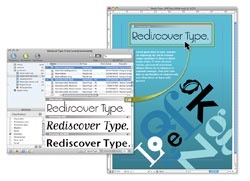By David Creamer
A year ago this past June, Extensis (http://www.extensis.com) released version 1 of Universal Type Server (UTS)—and now version 2 is hot on its heels with some nice new features that are going to be of special interest to larger companies with many users. While both the Pro and Lite versions have had general speed enhancements and the obligatory bug fixes, most of the major new features affect the Pro version.
The biggest new feature is the Directory Integration Module, which allows the continual one-way synchronization from Microsoft’s Active Directory or Apple’s Open Directory. This is more convenient than simply importing the information, since new users and changes are updated automatically. The good news is this module was originally included free for a limited time in version 2, but is now a permanent part of version 2.1.
Another major new feature is the ability to use an external SQL database to manage the font, workgroup, and user data rather than using the built-in UTS database. The main advantage is an increase in speed and response time by offloading some of the work from UTS. However, this module is optional and costs $4,235, so this would be mainly of interest to companies with a large user base. Version 2 originally only supported Microsoft SQL Server, but version 2.1 added support for the popular MySQL, which is cross-platform.
Installation of the server and the client software was very easy. Once the server install is complete, the default Web browser opens to the web-based admin interface. Since the administration is browser-based, it can occur from any system. Just like the first version, Workgroups, Roles, and Users are set up in the admin window. Users can be assigned to multiple workgroups with different roles (permissions) per group, such as the ability to add fonts to the server in one workgroup but not another.
Users can have their own personal workgroup to add fonts without those fonts being available to all users, plus these workgroups can be stored on the server so they’re available at any computer the user logs into or on a single computer. If the user attempts to bypass UTS by adding problem fonts directly into the computer’s font folder(s), an administrator can turn on Enforce System Font Policy, which limits what fonts can be added and will remove unapproved fonts automatically.
The client interface looks very similar to Extensis Suitcase Fusion, so it should be comfortable to users switching from Suitcase to UTS. The client software can be installed on as many computers as one wishes—the server will automatically limit the users to the number the license allows. That way, a company doesn’t have to over purchase client licenses, but can maintain a number of floating licenses for occasional use.
Font compliance is easy to set up, albeit a tedious process. Once set up, it will limit the number of users that can activate a font based on the font license restrictions, plus one can generate reports of usage, which can be exported to a tab-delimited file. An admin user can see exactly who’s adding fonts to the workgroups and remove them if necessary.
Other enhancements include (to name but a few) better font corruption checks and repair; speedier auto activation for Adobe InDesign and Illustrator CS2/3/4, plus QuarkXPress 7 and 8; and cross-platform backup of the server database. In my tests, everything worked as expected without glitches.
The cost of the product listed below is for new purchasers. The good news is that owners of UTS version 1 Pro get a free upgrade since they received a one-year service agreement with their purchase. (Version 1 shipped on 6/18/08 and 2 shipped on 6/17/09.) If the service agreement expires, upgrades from Pro version 1 to version 2 are $1,061.45, and Lite users can upgrade to UTS 2 Lite for $697.50. Extensis should be commended for releasing this version within the one-year service agreement time — they could have easily delayed the release and charged upgrade fees from every user.
Rating: 9 out of 10
(This review is brought to you courtesy of “Layers Magazine”: http://www.layersmagazine.com ).



